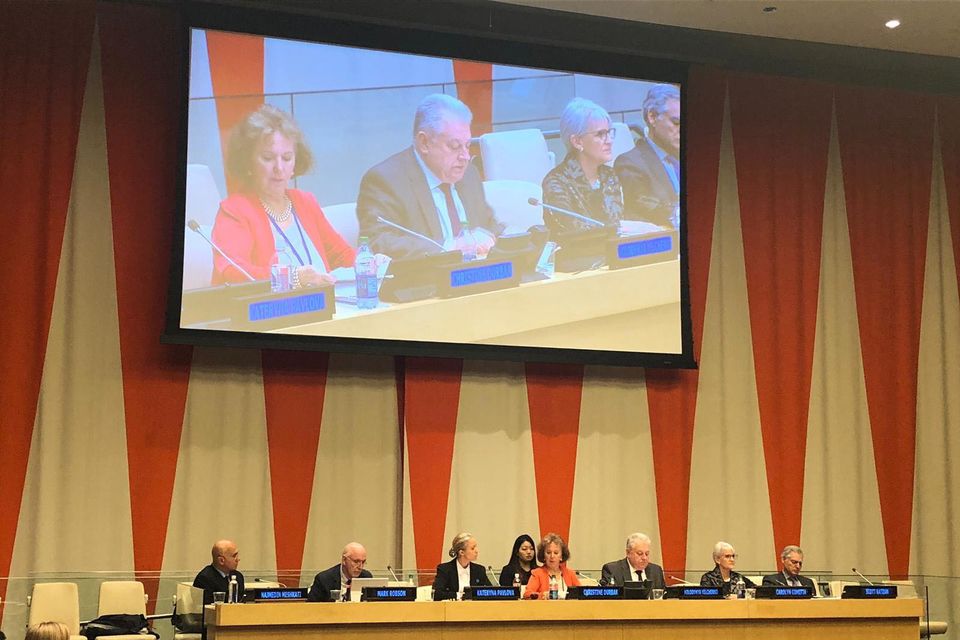Remarks by Mr. Volodymyr Yelchenko, Permanent Representative of Ukraine to the United Nations, at the 28th International Conference “Achieving Sustainable Goals. Chornobyl at 33”

Excellencies,
Dear colleagues,
Distinguished guests,
We are pleased once again to join this essential open dialogue on different aspects of Chornobyl legacy, which has already became a long lasting tradition for the UN Headquarters.
First of all let me thank Doctor Christine Durbak of the World International Transfer, Conference Chair and Founder, for being our supporter and partner for so many fruitful years.
And I would also like to welcome our distinguished speakers of today’s conference.
As Doctor Durbak have already mentioned, the primary focus of the attention of the UN member states is the achievement of the Sustainable Development Goals.
In line of the mentioned above call, Ukraine is deeply committed to full and comprehensive implementation of 17 Goals and 169 targets adopted by the United Nations General Assembly on September 2015.
It should be specially noted thatUkraine is one of the leaders in the region in terms of adaptation and incorporation of the SDGs into national legislation.
We keep on working to fulfill our commitments on SDGs related to improving the quality of education, promoting gender equality, and ensuring environmental sustainability.
I would like to point out that the approach of the new United Nation system must ensure comprehensive consideration of security, social and environmental aspects, particularly in priority areas such as ecological safety, comprehensive environmental conservation and risk reduction management. Only such approach will facilitate sustainability and efficiency of developing world.
Dear colleagues,
Today Ukraine marks 33 years since the Chornobyl disaster, the world’s worst nuclear accident.
In 1986 one of major humanitarian challenges has stricken Ukraine, its neighboring and other European countries, exposing the unidentified problem of thousands of internally displaced people.
This disaster changed the history of the mankind and is recorded in its fabrics as sad and tragic page. The humanity did not know such technological catastrophe before in terms of its scope and complexity of long-standing humanitarian, environmental, health, social and economic consequences. This catastrophe disrupted the livelihoods of almost 2 million people in more than 2000 affected locations.
Dear colleagues,
Ukraine has made every effort to improve the well-being of affected communities and revive the afflicted districts’ economic potential. Strengthening the resilience of affected communities and restoration of their self-reliance is the foundation for their sustainable development and our utmost priority.
Unfortunately, after more than three decades, the affected areas are still suffering from the impact of the accident.
Supported by UN agencies as well as our European partners, Ukraine has successfully implemented international projects aimed at sustained recovery and development of affected areas.
I would like to emphasize that the shift from restoration of the area to its sustainable socio-economic development can only take place if radiation safety requirements are fully met. Therefore, Ukraine, together with our European partners, is focusing on transforming the Shelter into an environmentally safe system and completing the construction of the New Safe Confinement.
In November 2016 the New Safe Confinement was erected. This construction project is unprecedented in the history of engineering. It is the largest moveable land-based structure ever built. Never before has such a huge structure been constructed at a heavily contaminated site.
The final step is the completion of the construction and commissioning of the facility.
Having completed the work on the construction of the New Safe Confinement, we will create all the conditions for the implementation of an ambitious project — the installation of a land-based solar panels in the Chornobyl exclusion zone.
Understanding the long-term nature of the implications of the Chornobyl accident, we find it essential to continue collaboration with the United Nations and other international organizations regarding the study and minimization of health, environmental and socio-economic consequences of the disaster.
Also within the implementation of Ukraine’s commitment under the Kyoto Protocol and “Energy Strategy of Ukraine till 2030”, in Chornobyl will be constructed a photovoltaic power station. For this purpose, the territory of a former sports stadium will be cleared and reconstructed.
We call on further financial support of the alternative energy development in the Exclusion zone.
Dear colleagues,
Strengthening the resilience of affected communities and restoration of their self-reliance is the foundation for their sustainable development and our utmost priority.
One of the primary lessons of Chornobyl was that the world should stay vigilant and united facing such disasters. Despite the considerable progress in rehabilitation of the affected areas, much remains to be done. The Chornobyl legacy will linger for a long while.
We should never forget about this.
I am convinced that there is a clear need for a continuous effort to keep the issue of post-Chornobyl recovery high on the inter-agency and international agendas. We must also continue to carry out various events within the UN and other international organizations dedicated to the consequences of the Chornobyl disaster.
I thank you for your attention and invite to join me at a friendly and professional discussion.
